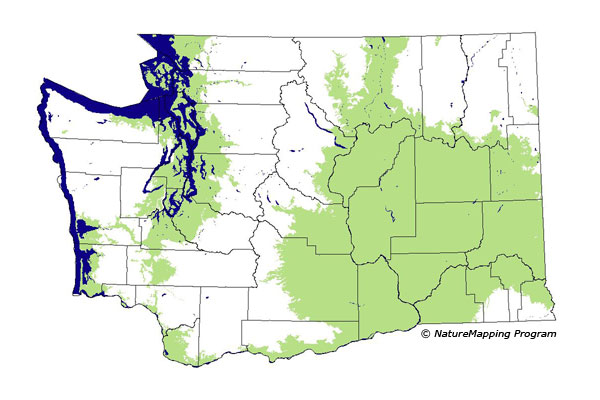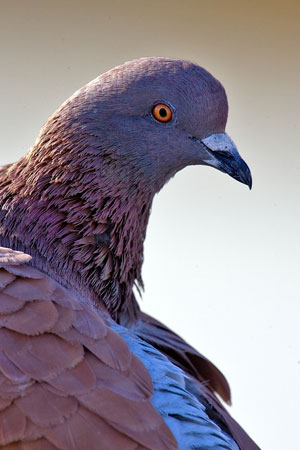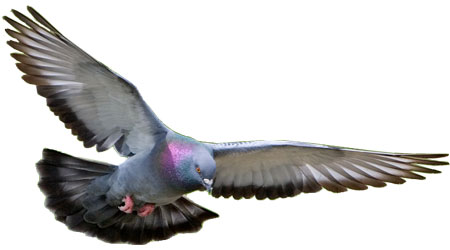

|
Rock Dove (Columba livia) 
Description: The rock dove or 'pigeon' has a dark bluish-gray head, neck, and chest with glossy yellowish, greenish, and reddish-purple iridescence along its neck and wing feathers. Females tend to show less iridescence than the males. The bill is dark grayish-pink. Two dark bands across the wings are seen in most pigeons, and one bluish-gray band across the tail. They have red eyes, and salmon-colored feet. 
Calls:
The call is a rolling "Coo, rooc'too-coo." Range / Habitat: Wild Columba livia are native to Europe, North Africa, and southwestern Asia. Feral pigeons are found worldwide, including throughout all of North America. Rock doves were introduced to North America by the earliest European settlers at Jamestown and Plymouth in the early 1600s. Most Rock Doves are seen in cities or farms, areas of considerable human alteration. This species is widespread and common at lower elevations throughout western Washington, mostly breeding in cities and farmlands. Their original native habitat is cliff-sides, and rock doves can be found in eastern Washington nesting on basalt cliffs along the Columbia River in the Columbia National Wildlife Refuge (Grant County). They are absent from heavily forested areas. Click the range map to learn more about the distribution of Rock Doves in Washington. Diet: Rock doves feed in the early morning and in the mid-afternoon on the open ground. They eat mainly seeds including corn, oats, cherry, and barley. In cities, feral pigeons also eat popcorn, cake, peanuts, bread, and currants. 
Nesting: In urban and suburban areas, pigeons nest on a variety of covered, flat surfaces, including ledges and beams in bridges and buildings. In natural areas, they nest on sheltered cliff-ledges. Pairs may be formed at any point during the year and they often form long-term bonds. Male and female birds work cooperatively on most aspects of nesting and rearing of the young. The male supplies nesting material, and the female builds the nest, a platform of twigs and grass. Nest sites are used repeatedly and nesting material is added for each new brood. A pair may raise 5 or more broods a year. Both parents incubate the 2 eggs for 16-19 days, and both feed the young 'pigeon milk,' a protein and fat-rich liquid produced in their crops. The young pigeons leave the nest at about 4 weeks of age. Behavior: They flock while roosting, sunning, and feeding. Pigeons generally walk or run while bobbing their heads forward and backward. They fly with a steady and direct path. Pigeons are most often seen during daylight - especially in urban parks or perched on buildings. They seek cover at night or during the heat of the day. Migration: Rock Pigeons do not migrate. However if displaced from a nesting area, they have a good homing ability and can return from long distances. It is thought that this ability evolved to help them find their own nests on cliffs covered with large colonies of similar looking nests. (BirdWeb) Did you know?
Animal silhouettes available to purchase » Photos: Natures Pics and Tim Knight
More Information: Home | About Us | How to Participate | Biodiversity Modules | Projects | Maps | News | Resources |